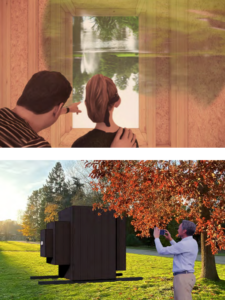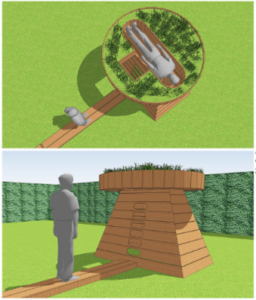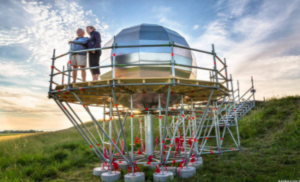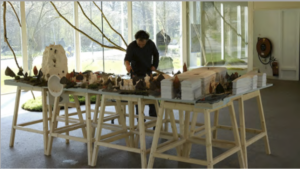Amstelpark, April 2022 – April 2023
On April 22, Earth Day, Zone2Source will open the Shadow Floriade to mark the 50th anniversary of the Amstelpark. In addition to the exhibitions Perfect Nature: Amstelpark Test Site, Our Living Soil and What the Trees of the Amstelpark Tell Us, Zone2Source presents temporary pavilions for the Shadow Floriade installed throughout the park, Camera Obscura, Contemplatorium, Universe and Building as Being.
In 1972 the park was constructed on the occasion of the 1972 Floriade. Fifty years later, we ask the question of whether a park in times of ecological crisis can be the place where people come together to practice new imaginations and experiences of nature. The temporary pavilions are inspired by the concept of the World Horticultural Exhibition, better known as the Floriade. The exhibition is characterized by architectural pavilions that are shaped by the theme of the expo. At a world exhibition, pavilions are places to experience and discover something new or interesting. The temporary pavilions and interactive building installations act as tools to better align ourselves with the natural environment. The pavilions will not only be restricted to places for human action, but the pavilions will also dive into non-human buildings and habitations.

Artist and architect Rick Abelen, sees the relationship between man and environment from the point of architecture as an interesting field of tension. That is why Abelen developed a Camera Obscura, which visitors can enter to see the Amstelpark from a new perspective. The Camera Obscura is a darkened space where the outside world enters upside down through a hole in the wall. As a precursor to photography – but a technique where there is still a direct connection with the environment – the installation takes the form of a folding camera.
The work will be placed in a spot overlooking the pond so that the reflection of the landscape on the water will also be part of the artwork. Visitors will be able to enter the building at any time, making you find yourself inside a camera where you perceive the world upside down. Perceiving the environment in an alienating way leads to more attention and reflection on details and shapes that we normally walk through thoughtlessly. When you come out again, the environment is just a little bit different than before you entered the Camera Obscura.

Rob Sweere is known for site-specific sculptures and installations that allow visitors to experience the world around them in an intense way. Awareness of the world around us, of the complexities of nature or even of the immeasurable universe, makes us get to know ourselves and our dependence on our environment better and take better care of it. Sweere’s installations are intended as tools for concentration and exercises for attunement to the natural environment. Meanwhile, Sweere invites people all over the world to enter into “conversations” with the sky or with trees. We need new rituals to recalibrate ourselves. The Contemplatorium offers a place for this.
The Contemplatorium is a combination between sculpture, landscape design and experiential art that is modular and can continue to evolve and manifest itself in the natural environment of a park. The Contemplatorium, which is publicly accessible to the public at all times, is a place where the public can find out for themselves how they want to use the artwork to allow personal and as yet unknown rituals to take place in connection with the natural elements. The Contemplatorium consists of several walkways that connect different objects. The whole thing is modular. This means that per location the walkways and the objects can be placed differently and it can be expanded in the future. The walkways and objects direct the visitor to new experiences and perceptions of the environment in a playful and inquisitive way – an area for developing yet unknown rituals that can lead to a deepening experience of our bodies in the environment.
 Universe – Robbert van der Horst
Universe – Robbert van der HorstRobbert van der Horst is an artist and architect whose work always interacts with the landscape: physically, historically and socially. Since 1995 he has been creating performances and temporary structures that question our relationship with the surrounding landscape. His interest in architecture is rooted in a long-running investigation into how we as humans connect to a place on earth and how vulnerable and precarious that position can suddenly become. He sees his structures as staging: by traversing a route, becoming detached from the ground, offering a new perspective and making the horizon visible, new space for experiences is created. Temporary structures express the relationship between home, man and horizon.
Universe is a research machine, an observatory, that rotates and from which we take in new perspectives on the environment. We are invited to reflect on the surrounding social, physical and historical landscape and to anchor our sense of place. Universe is an existing work that Robbert will adapt especially for the Shadow Floriade and the Amstelpark. For instance, he developed a new power plant that illuminates a lamp by slowly lowering a large weight. The weight is hoisted up again by the visitors themselves. This new coupling technique will be used in this new version of Universe. From the rotating elevated platform around a sphere that mirrors the surroundings and the sky, we see the Amstelpark differently than the beaten paths of the park, and we are asked to orient ourselves differently to the place we occupy.

What do people build for, what does it mean to build, how has building evolved over time, and how can we build sustainably for the future? Building as Being explores these questions in collaboration with architects, designers, ecologists, earth scientists, artists and the general public. Forms tend to grow through the principle of self-organization, where order emerges from chaos, without a master controller.
The designer collective Zoo of the Future (ZOOOF) is building a pavilion around the habitat of animals. During the Zoo of the Future (2020) exhibition, ZOOOF engaged in speculative design around future relationships between humans and non-human organisms. For the installation, the collective collaborated with artist and geologist Esmee Gerken. By defining the park as a location where humans and other life forms meet, the notion of design is seen as co-design. This means that the park takes shape through a collaboration with non-human users. The concept is connected to the Shadow Floriade because it takes a look at the possibilities of non-human architecture.
Amsterdam is home to a number of forms of architecture made specifically for non-human organisms. The bat shelter and the walkways for squirrels across the Europaboulevard are examples from which the idea of ZOOOF and Zone2Source to design new architecture for the voluntary non-human inhabitants of the Amstelpark arose. To recognize animals as residents of the city, a number of workshops will be held with design students, adults and children from the neighborhood, and local animals. During the workshops, based on observations of nature, they will build semi-temporary residences for animal life in the Amstelpark.